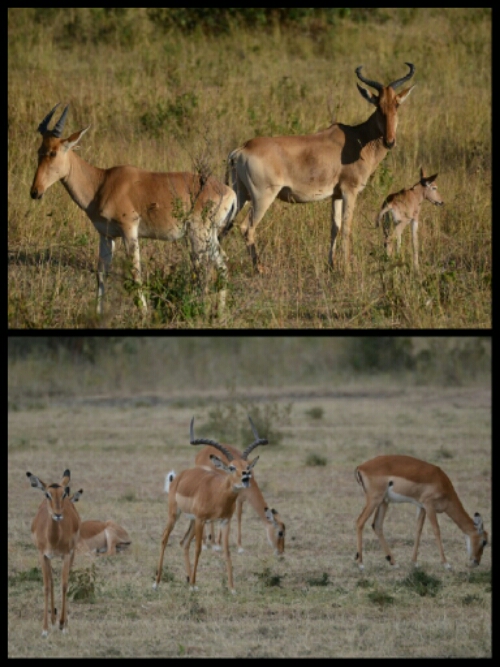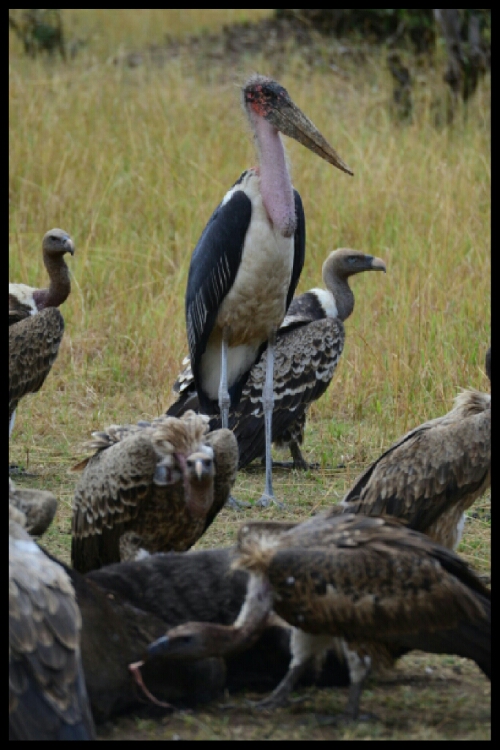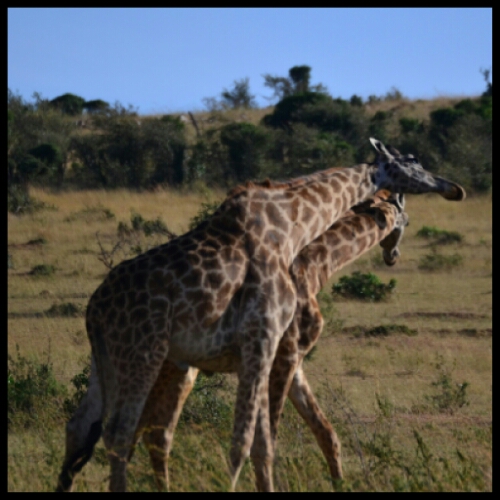Our plane touched down just as the sun started to peep over the horizon. I was very excited because I’ve dreamed of visiting Kenya for as long as I can remember wanting to go anywhere. Exiting Nairobi airport, the Kenyan component of our three-stage trip began with a densely packed line of tour guides and hotel reps jostling – albeit in a very restrained manner – for position, brandishing an array of client names. After walking past a few times, we spotted ours held by David, our driver and guide for the next four days. This airport collection was a first so it made us feel pretty fancy and signified the start of a different kind of trip to our usual independent approach.
Rush hour in Nairobi had already begun so we queued through the city en route to the office of Kenya Budget Safaris. The city had recently hosted Barack Obama so, David explained, the deep-red soil of the central reservations on the route from the airport had been cleaned up and planted with flowers. Obama passed in the dark and the flowers lasted just a week.
The roadsides teemed with people walking to work in the nearby factories and offices, many wearing thick jumpers much to our surprise. Seeing so many people on foot was a stark contrast to many countries in Asia and South America where locals use bikes, motorbikes and tuktuk. Now and again, amongst those striding out purposefully, meandered the poorest people, dressed in rags and picking over rubbish, adding items to their sacks.
Between the rows of traffic jammed vehicles walked vendors selling all sorts: tea towels, grapes, CDs, flags, sweets, kites and neck ties. David accepted a free newspaper for later and chatted to us about football, lamenting the state of the Kenyan game and pledging his support for Arsenal.
After a brief stop at the office, we made ourselves comfortable in the seven-seater van (a 4×4 toyota hi-ace van, the most common vehicle used for safaris here) and started getting to know our guide.
David was from the Kikuyu tribe, the largest in the country (22%). They no longer dress traditionally and identify as Christians but still retain many tribal beliefs and customs. He has two sons aged 10 and 19 and said that younger generations were becoming more modernised and less interested in their cultural heritage. Kikuyus, as a group, are very business minded, wise with their money and hard-working. David certainly represented them well, being friendly, intelligent, professional and, importantly for us, a very safe and sensible driver. Here he is playing football with a little Maasai kid:
The road to the Great Rift Valley offered plenty of diverting sights: goats standing on their hind legs to nibble bushes; grazing turkeys, donkeys and ducks; red-ribboned funeral car processions; sheep skins drying in the sun; roadside grilled corncobs; and lush, green, tree-filled landscapes. We stopped to take in the view which didn’t photograph well!
Continuing our journey, we entered Maasai land. We could have been in a different country altogether. The red soil gave way to dry, dusty yellow-brown earth and the tall trees were replaced by small shrubs, cacti and thorny acacias.The temperature increased noticeably too. The walking continued though: we were continually surprised to see people improbably far from the closest village or even building!
The Maasai are traditionally nomadic pastoralists who, despite only making up 0.7% of Kenya’s population, are the most well-known tribe due to their exploitation by the tourism industry. For years they have held steadfastly to their traditions but today many in Kenya opt for western clothing, permanent villages and the irresistible pull of technology. Still, those who remain unchanged can easily be seen, swathed in red shukas, with stretched earlobes, shaven heads and beaded jewellery adorning their necks, ears, heads and arms (men and women).
The cattle are central to their culture giving sustenance in the form of meat, milk and blood, dung for house construction (by women), and skins for bedding and sometimes clothing. Young Maasai are encouraged to go to school but many instead herd the cattle or stay home to help with chores. All too often, we saw a lone child, some no taller than a goat, wandering across the parched terrain alongside a group of grazing animals. David says they enjoy the responsibility and the power of controlling the animals though so perhaps it’s not as bad as it seems to us. Most Maasai men didn’t seem to do much, especially in comparison to the women, but some did herd the cattle with the aid of the iconic pointed staff.
After about six dusty, bumpy hours, we entered a tiny Maasai ‘town’ and pulled into a campsite. We were shown to an aging but large tent containing a reasonably comfortable bed and a holey mosquito net. Excuse the mess – the bed was the only furniture!
At the back was a breeze-block en-suite with very questionable cleanliness standards and only reachable via a sharp rogue nail we both had run-ins with! Hot water was provided via a fire under a tank. Electricity was available for a few hours morning and night but this wasn’t a problem given we’d be up at dawn, busy all day and tired enough to sleep very early. The breakfasts were good: eggs, sausages, toast and pancakes. The packed lunches were dire. The evening meals were a basic traditional buffet of cabbage, tough beef stew, rice and spinach. Given the remote location and our budget fee, this was more than we expected and so we were quite content.
Here in the Masai Mara, we did three game drives: an evening, a full day and an early morning. We would stand in the back with the roof up as David covered mile after mile, stopping when we asked or exhileratingly racing onward to a specific animal sighting he’d heard about on the guides’ radio communication system.
In terms of accessibility, it was the best park of the five we visited as there were so many winding, converging roads, meaning smaller distances from the animals. The landscape was the most varied moment to moment too, as it was both hilly and flat, green and dry, with grass, rocks and rivers.
Rather than describing each day separately, here are the animals we met, accumulated in photographic form.
The most common animals – there were thousands – were the wildebeest and zebra. They seemed pretty content to hang out together but exhibited quite different characteristics. The wildebeest were incredibly skittish and, even if you were nowhere near, would dash theatrically in some direction or other, legs and mane flailing everywhere, then would stop at a safe distance and glare at you.
In contrast, zebras – the laid back, chilled out punks of the savanna – would usually just casually sidle away, with no chance of disturbing their mohicans. Left undisturbed by humans, both animals would walk in long organised lines with lengthy pauses in new grazing areas. The zebras would nuzzle or nurse their young or tessellate with family members under a shady tree.
There were also more antelope than you could count, ranging from the tiny dik-dik to the huge eland. Here we have hartebeests, impalas, another impala, a topi and battling Thompson’s gazelles.
We saw elephants too, although not a huge number.
There was some small bird life but the bigger birds made more of an impact. Below are a blue heron, a lilac-breasted roller and a secretary bird followed by a female ostrich. Then you’ll find a set of vultures devouring a wildebeest overseen by a maribu stork in the manner of a teacher on playground duty I felt! The latter photos are not for the fainthearted and the smell was unspeakably pungent!
Of course there were the serene, towering giraffes, nibbling away at acacia trees, always in groups of two to six. I loved seeing panoramas containing several amazing animals like the second photo down.
We were lucky enough to witness a fight between two males. Thankfully they gave up after a few minutes before either was hurt.
The big cats were definitely the most exciting finds as they were hard to come by and drew a lot of attention from all the vans. It was amazing to get so near such powerful beasts and we kept thinking how cuddly they looked and wondering why anyone would kill them for pleasure. We found several lions in ones or twos and had two separate cheetah sightings. Again, it’s probably not best to view those if you’re eating or not a fan of gore. Both were eating recently hunted wildebeests. The first one was particularly exciting as we were able to get pretty close.
Finally here are a few other sightings: a warthog, a buffalo, a crocodile, a troupe of baboons and some distant sleeping hippos.
Before leaving the Masai Mara, a few essential maintenance jobs were performed by Francis the village mechanic – regularly needed due to the terrain the vehicle endures. Meanwhile we observed village life.
On we travelled – discussing education, health, women’s rights, political corruption, roads and marriage – to a town called Nakuru and a place named Chester Hotel which was far nicer than anticipated aside from the cold showers.
On Sunday morning, as Kenyans were largely dressed in their Sunday best and heading off to church, we embarked upon the second part of our safari with David – Lake Nakuru. We’d selected it for a change in scenery – forests and water – and for the chances of seeing rhinos. We weren’t disappointed in either case.
This was our lunch spot view and our packed lunch – one of the best we experienced. What the pictures don’t show is the enormous quantity of baboon droppings under, on and around the picnic tables!
The lake became famous due to millions of migrating flamingos. However recent years’ high water levels have meant they’ve had to adopt another lake. A select hardcore few came anyway. Just behind the flamingos with the buffalos were a pair of hippos!
As with the Masai Mara, there were plenty of carcasses in varying stages of decomposition! This is the least foul-smelling stage!
Here are the rest of our sightings for the day starting with olive baboons:
A family of shy portly warthogs, trotting about, seeing to business.
Impalas and waterbuck:
A very friendly giraffe came closer than expected!
A vervet monkey.
Buffalo – the least exciting of the ‘big 5’ but still pretty cool!
Birdlife: lilac-breasted roller, some kind of eagle, a hoopoe and a superb starling (as common as sparrows or pigeons in some places!)
Late in the day we followed radio intelligence to this group of white rhinos, snoozing under a tree with some buffalo. Luckily (for us, not them), the buffalos got restless and disturbed them so we had the opportunity to see them stand up and move about a bit.
And that concluded our time in Kenya. We parted ways with David back in Nairobi and got a good night’s sleep in readiness for the next day’s journey to Tanzania.






































































Wonderful blog and photos, thank you, feel like I’ve been on safari now xxx
Sent from my iPad
>